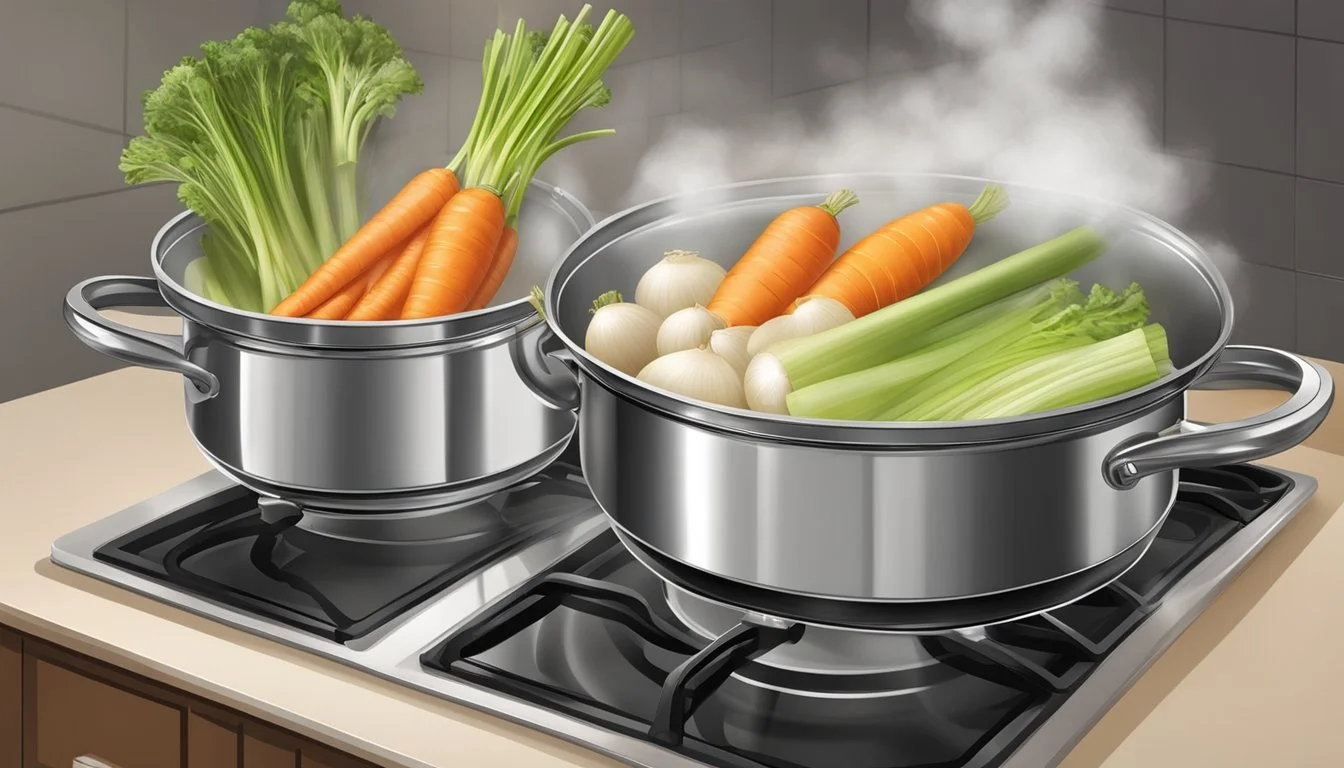Bone Broth Essentials
Elevate Your Broth with Onions, Carrots, and Celery
Bone broth is a nutritional powerhouse that has been cherished for its rich flavor and health benefits. Integrating simple vegetables like onions, carrots, and celery can elevate the taste and nutritional profile of your homemade broth. These aromatic vegetables not only add depth to the flavor but also enhance the overall experience, making the broth more enjoyable to consume.
Onions bring a subtle sweetness and complexity to the broth, pairing perfectly with the earthiness of the bones. Carrots contribute a delicate, slightly sweet flavor and a vibrant color, enriching both the taste and visual appeal. Celery's distinct, slightly peppery taste rounds out the trio, contributing to a balanced and flavorful broth that can be used in a variety of dishes.
Combining these key ingredients with bones, herbs, and spices creates a fragrant and delicious broth that is both nutritious and versatile. Whether you are sipping it on its own or incorporating it into recipes, enhancing your bone broth with onions, carrots, and celery is an effortless way to maximize its flavor and benefits.
The Fundamentals of Bone Broth
Making a high-quality bone broth requires understanding its basics, distinguishing it from stock, and selecting the right bones for optimal nutrient extraction and flavor.
Defining Bone Broth
Bone broth is a nutrient-rich liquid made by simmering animal bones and connective tissues. Unlike regular broth, it is cooked for an extended period, typically 24 to 48 hours. This long cooking time helps extract vitamins, minerals, collagen, and gelatin from the bones, contributing to the broth's rich flavor and nutritional benefits.
Key Ingredients:
Bones: Beef bones, chicken bones, and marrow bones.
Vegetables: Onions, carrots, and celery.
Acidic Elements: Apple cider vinegar or lemon juice for nutrient extraction.
Avoid the crowds and shop for apple cider vinegar online from the comfort of your home!
Bone Broth vs. Stock
Bone broth and stock may seem similar but have distinct differences. Stock is usually cooked for a shorter period, around 2 to 6 hours, and primarily serves as a base for soups and sauces. It focuses on extracting flavors from the bones and any attached meat, whereas bone broth emphasizes nutrient extraction.
Comparison Table:
Feature Bone Broth Stock Cooking Time 24-48 hours 2-6 hours Main Focus Nutrient extraction Flavor extraction Ingredients Bones, vegetables, acidic elements Bones, vegetables Texture Gelatinous when cooled Less gelatinous
The Importance of Quality Bones
The type and quality of bones used greatly impact the nutritional value and flavor of the bone broth. Using bones from healthy, pastured animals ensures a richer, more nutrient-dense broth. Marrow bones are particularly desirable for their high gelatin content, which adds both texture and health benefits.
Recommended Bones:
Beef Bones: For a rich, robust flavor and high collagen content.
Chicken Bones: For a lighter broth, often more delicate in taste.
Marrow Bones: These add a gelatinous consistency and depth to the broth.
To achieve the best results, always choose fresh, high-quality bones and supplement with vegetables and acidic elements to maximize nutrient extraction.
Key Ingredients for Flavor and Nutrition
Understanding the importance of vegetables, aromatics, and acids can significantly enhance the flavor and nutritional value of bone broth. Each component offers specific contributions, making your broth more delicious and beneficial.
Role of Vegetables in Bone Broth
Onions, carrots, and celery form the classic base for many stocks and broths due to their balanced flavor profile. Onions impart a mild sweetness and depth, while carrots add a subtle sweetness and color. Celery provides a slightly peppery note that complements the sweetness of the other vegetables. These vegetables are often referred to as mirepoix, a traditional flavor base.
Nutritionally, these vegetables are rich in essential vitamins and minerals. Onions contain vitamin C and antioxidants, carrots offer beta-carotene which is converted to vitamin A, and celery provides vitamin K and folate. Adding them to your bone broth ensures a nutrient boost.
Enhancing with Aromatics
Garlic, herbs, and other aromatics elevate the flavor profile of bone broth. Garlic introduces a rich, savory taste and has antimicrobial properties. Fresh herbs such as thyme, parsley, and bay leaves add layers of complex flavors and subtle earthiness.
Using dried herbs can also be effective; they release their flavors slowly, contributing to a more rounded and deep flavor over the long cooking period. These ingredients help to transform a simple broth into a satisfying and therapeutic beverage.
Importance of Acids
Acids, like apple cider vinegar, play a crucial role in bone broth. Adding a small amount of vinegar assists in breaking down the collagen and marrow in the bones, releasing beneficial nutrients into the broth. The acid helps to extract calcium, magnesium, and other trace minerals, making the broth more nutrient-dense.
A typical ratio would be a tablespoon of vinegar per quart of water. The acidic taste also balances the richness of the broth, contributing to a more well-rounded and enjoyable flavor. Using unfiltered, organic apple cider vinegar is recommended for maximum health benefits.
Cooking Techniques Explained
Several methods can be used to cook bone broth, each affecting flavor, nutrient retention, and cooking time. Key techniques include simmering, choosing the right cooking method, and understanding the impact of cook time on nutrients.
Choosing Your Cooking Method
The method selected for cooking bone broth influences both the flavor and the nutrient content. Common methods include using a stove, slow cooker, instant pot, and pressure cooker.
On the stove, simmering allows for gradual flavor extraction but requires frequent monitoring. A slow cooker offers convenience with steady low-heat cooking, ideal for overnight preparations. The instant pot or pressure cooker speeds up the process significantly, making it a good option for busy individuals. Whichever method you choose, always ensure bones and vegetables are preliminarily roasted to deepen the broth's flavor.
Experience the convenience and savings of buying slow cooker online!
The Art of Simmering
Simmering is crucial for developing a rich and flavorful broth. When using the stove or a slow cooker, it’s important to maintain a gentle simmer rather than a rolling boil. Boiling can create a cloudy broth and worsen the flavor.
Keep the water just below boiling point for several hours. This slow process breaks down collagen in the bones, releasing gelatin, which enriches the broth. In an instant pot or pressure cooker, the simmering process happens at high pressure, shortening the total cook time while still breaking down the bones adequately.
Effect of Cook Time on Nutrients
Cook time impacts nutrient extraction and flavor concentration. Longer cooking times, typical of the slow cooker or stove method, generally yield more gelatin and mineral content. Simmering for 12-24 hours ensures maximum nutrient extraction.
However, using an instant pot or pressure cooker reduces the cook time to 3-4 hours while maintaining substantial nutrient levels. Overcooking can degrade certain heat-sensitive nutrients, so balancing cook time and method is essential. Regular monitoring and adjusting the heat ensures a nutritious and well-flavored broth.
Nutritional Components of Bone Broth
Bone broth is renowned for its rich array of nutrients, including collagen, gelatin, amino acids, and essential minerals that contribute significantly to its health benefits.
Collagen and Gelatin
Collagen and gelatin are two of the primary components that distinguish bone broth. Collagen, a major structural protein in bones and connective tissue, breaks down into gelatin during the slow cooking process.
Gelatin enhances the broth's texture and offers various health benefits, such as improved joint health and digestion. Collagen and gelatin are rich in important amino acids like glycine, proline, and hydroxyproline. These amino acids support skin elasticity, wound healing, and overall connective tissue strength.
Both collagen and gelatin aid in maintaining healthy bones and joints. They also contribute to the broth's nutrient density, providing a substantial source of protein that can supplement daily dietary needs.
Amino Acids and Proteins
Bone broth is a potent source of various amino acids and proteins that are crucial for the body's functioning. Glycine, proline, and glutamine, found abundantly in bone broth, play key roles in muscle repair, gut health, and immune function.
Amino acids like glycine also help in detoxification processes and promote restful sleep. Collagen-based proteins enhance skin health and support the regenerative processes of tissues.
Additionally, bone broth contains various essential minerals such as calcium, magnesium, potassium, and iron. These minerals are vital for metabolic processes, bone density, and overall well-being. The nutrient profile of bone broth makes it a valuable addition to a balanced diet, providing both macro and micronutrients essential for health.
Health Benefits of Regular Consumption
Regular consumption of bone broth offers numerous health benefits, particularly for joint health, digestion, and inflammation. The following sections detail the specific impacts of bone broth on these key areas.
Bone Broth for Joint Health
Bone broth is rich in collagen, which is essential for maintaining healthy joints. Collagen helps to preserve the integrity of cartilage, which cushions joints and can reduce pain associated with conditions like arthritis.
Bone broth contains glucosamine and chondroitin, compounds found in connective tissues. These compounds are known to support joint health by reducing inflammation and promoting the repair of cartilage.
For those dealing with joint pain, adding bone broth to their diet can provide relief. The amino acids in bone broth, such as glycine and proline, further contribute to maintaining flexible and pain-free joints.
Gut Health and Digestion
Bone broth is beneficial for gut health and digestion because of its gelatin content. Gelatin helps to rebuild the intestinal lining, which can improve nutrient absorption and support a healthy gut barrier.
It also aids digestion by attracting digestive juices to food. An improved gut lining can alleviate symptoms of conditions like leaky gut syndrome and decrease food sensitivities.
The amino acid glutamine in bone broth supports gut health by maintaining the integrity of the gut mucosa, which is the first line of defense against harmful bacteria and toxins.
Bone Broth's Role in Inflammation
Regular consumption of bone broth can play a significant role in managing inflammation. Bone broth contains anti-inflammatory amino acids like glycine and arginine that help reduce inflammation throughout the body.
Chronic inflammation is linked to many health issues, including arthritis, heart disease, and autoimmune conditions. By reducing inflammation, bone broth supports overall health and can potentially reduce the risk of these conditions.
Glutamine's anti-inflammatory properties also contribute to healing the gut and reducing systemic inflammation. Making bone broth a part of your diet can thus provide these benefits, promoting a healthier inflammatory response in the body.
Bone broth is a nutritious addition to any diet, offering a range of health benefits from improved joint health and digestion to reducing inflammation.
Incorporating Bone Broth into Your Diet
Bone broth offers numerous benefits, including improved joint support and gut health. Integrating it into your meals is simple and can be done in various creative ways.
Making Soups and Stews
Bone broth is an excellent base for soups and stews. It adds depth and nutrition to dishes like chicken soup, beef stew, and vegetable broth. By replacing water with bone broth, you incorporate the amino acids and collagen that support skin, hair, and joints.
For a hearty chicken soup, boil bone broth with diced onions, carrots, and celery. This not only enhances the flavor but also provides additional nutrients. Bone broth can also replace water in recipes for stews, lending a richer taste and increasing the protein content.
Beyond Soups: Versatile Uses
Bone broth's versatility extends beyond traditional soups and stews. Use it as a savory liquid for cooking grains like quinoa and rice. This infuses these dishes with extra flavor and nutritional benefits.
When sautéing vegetables, replace water or oil with bone broth. This not only steams the veggies but also adds a layer of gelatin to the dish. Bone broth can also be used to create flavorful sauces and marinades, offering a wholesome twist to your favorite recipes.
Bone Broth as a Beverage
Drinking bone broth as a beverage is an easy way to enjoy its benefits. Enjoy a hot mug of bone broth in the morning for a nutritious start to the day. This practice can also help reduce inflammation and support gut health.
You can personalize your bone broth beverage by adding spices like turmeric or ginger. Some prefer to add a splash of apple cider vinegar for a tangy kick. As a warm and soothing drink, bone broth can be a healthier alternative to coffee or tea.
The Cooking Process Detailed
Creating a flavorful bone broth involves key steps such as roasting bones, preparing vegetables like onions, carrots, and celery, and following a simmering schedule.
Roasting Bones for Depth of Flavor
Roasting the bones is essential for adding depth to the broth. Preheat the oven to 400°F. Arrange bones—such as beef, chicken, or pork—in a single layer on a baking sheet. Grass-fed beef bones or chicken feet can enhance the collagen content.
Optionally, rough-cut vegetables (onions, carrots, and celery) can be included for added flavor. Roast bones and vegetables for 30-45 minutes until browned. This caramelizes the sugars and releases fats, contributing robust flavors to the broth.
Preparation of Ingredients
Chop 4 large carrots and 2 medium onions into chunks. Halve 2 heads of garlic and cut 6 stalks of celery. Gather 4 bay leaves, ¼ cup peppercorns, and 2 tablespoons of apple cider vinegar.
Use fresh or dried herbs based on availability. Loading a crockpot or stockpot with bones and vegetables, fill with filtered water to cover the ingredients. The vinegar assists in breaking down the collagen and minerals in the bones.
The Simmering Schedule
Cover and cook the mixture on low heat for 24 hours. During this long simmer, the bones release gelatin and nutrients into the broth. It’s vital to maintain low, steady heat; rapid boiling can obscure the broth's clarity and flavor.
Occasionally skim off any fat or foam forming at the surface. After cooking, let the broth cool to room temperature. Strain through cheesecloth or a fine mesh strainer to remove solids, leaving a rich, clear bone broth.
Proper seasoning with salt or sea salt, applied towards the end of cooking, ensures balanced flavor. The resulting broth is nutrient-dense and ready for use in a variety of dishes.
Customizing Your Bone Broth
Bone broth can be tailored to fit various diets, made from different types of bones, and enhanced with unique flavors. Below are several ways to personalize your broth.
Adapting the Recipe for Dietary Needs
Customization can make bone broth suitable for a variety of dietary restrictions. For example, those on a Paleo diet might prefer using grass-fed beef bones and organic vegetables.
To make a keto-friendly broth, include fat sources like coconut oil or ghee. Vegetarian alternatives can be created by using vegetable broth with ample amounts of onions, carrots, and celery.
Use allergen-free options by carefully selecting ingredients free from common allergens like gluten or dairy. Adjust seasoning levels to meet sodium restrictions by opting for low-sodium sea salt.
Exploring Different Bone Types
Using bones from different animals can significantly alter the broth’s flavor profile and nutritional content. Beef bone broth provides a rich and hearty base, ideal for substantial soups and stews.
In contrast, chicken bones offer a lighter, milder flavor. Fish bones, particularly from fatty fish, contribute omega-3s and make for a unique taste.
Experimenting with a blend of mixed bones can provide a more complex flavor. Always ensure bones are organic and grass-fed if possible, to eliminate contaminants and maximize health benefits.
Experimenting with Flavors
Enhancing the flavor of bone broth involves using a mix of herbs and spices. Fresh herbs like thyme and rosemary can add a fragrant touch. For a bit of warmth, consider ginger and turmeric, known for their anti-inflammatory properties.
Adding acids such as apple cider vinegar helps to extract more nutrients from the bones while balancing the richness.
Incorporate vegetables like garlic, onions, carrots, and celery to deepen the flavor. For a richer broth, a splash of coconut aminos or a dash of sea salt can make a significant difference. Adjust these additions based on your personal taste preferences and the final dish's requirements.
Troubleshooting Common Issues
Ensuring clarity and balancing flavors are essential in perfecting your bone broth. Below are specific techniques to avoid common pitfalls such as cloudy broth, over-salting, and excess fat.
Avoiding a Cloudy Broth
A cloudy broth usually stems from impurities or excessive agitation during cooking. Start by blanching the bones in boiling water for about 10 minutes to remove impurities. Then, rinse them thoroughly and gently simmer at a low temperature in the stockpot. Avoid bringing the broth to a rolling boil, which agitates the ingredients and releases particulates that cloud the liquid.
Skimming the foam and impurities from the surface during the initial simmering phase also enhances clarity. Using fine-mesh strainer when pouring the broth into containers can further help remove any remaining particles.
Controlling Salt and Seasoning
Balance in salt and seasoning is crucial. If the broth tastes bland, it can be tempting to add a lot of salt immediately. Instead, add salt gradually and taste frequently. Using fresh herbs and spices can also enhance flavor without the need for excessive sodium.
To avoid over-salting, use low-sodium ingredients especially if adding store-bought broths or stock cubes. Remember, reducing a broth can intensify its saltiness; it’s better to start with a lower amount and adjust as needed after reduction. Adding a splash of acid like lemon juice can brighten flavors without more salt.
Dealing with Unwanted Fat
Excess fat can make the broth greasy and unpalatable. A simple way to remove fat is by skimming the surface with a spoon during the cooking process. For a more thorough method, chill the broth in the refrigerator. The fat will solidify on the top, making it easy to lift off and discard.
Using a fat separator can also be effective. Pour the broth through the separator, which will trap the fat and allow the clear broth to flow through. Additionally, using leaner cuts of bones and trimming excess fat before cooking reduces the initial fat content in the broth.
Advanced Tips and Techniques
Elevate your bone broth by optimizing nutrient extraction, implementing effective storage solutions, and efficiently scaling up production. Each technique helps ensure your homemade broth is both nutrient-dense and convenient for future use.
Maximizing Nutrient Extraction
To extract the most nutrients from bones, add a small amount of acid like apple cider vinegar. This helps release minerals such as calcium and phosphorus. Use 2 tablespoons of vinegar per gallon of water.
Slow cooking is critical. Simmer the broth for at least 12 to 24 hours. This long cooking time ensures greater collagen and nutrient extraction.
Maintain a gentle simmer to avoid cloudiness. Constant boiling can make the broth murky and less palatable.
Storage and Preservation
For effective storage, cool the bone broth quickly after cooking. This minimizes bacterial growth. Use airtight containers to keep the broth fresh.
Freezing is an excellent long-term storage method. Pour broth into ice cube trays for easy portioning. Once frozen, transfer the cubes to zip-lock bags.
Label containers with the preparation date. Frozen broth stays good for up to six months, while refrigerated broth should be consumed within a week.
Scaling Up Production
Scaling up bone broth production requires larger equipment. Consider investing in an 8-quart stock pot or a pressure cooker.
A pressure cooker reduces cooking time significantly while maximizing nutrient extraction. Aim for a 2-hour cook time for efficient results.
Batch cooking can save time. Prepare large batches and store them in a mix of smaller and larger containers to suit different meal needs. This method ensures you always have nutrient-dense broth on hand.
Monitoring ingredient quantities is crucial. Maintain the correct bone-to-water ratio to avoid diluting the nutrient content.
Understanding the Scientific Research
Scientific studies have explored the nutritional components and potential health benefits of bone broth. Key research has focused on nutrient extraction, anti-inflammatory properties, and popular misconceptions.
Reviewing Key Studies
Several studies have analyzed the nutrient profile of bone broth. Research indicates that ingredients such as onions, carrots, and celery can enhance the broth's nutritional content.
Nutrients like collagen, glycine, and minerals are often highlighted. A specific study examined the anti-inflammatory benefits of bone broth using a murine model with ulcerative colitis, showing promising results in reducing inflammation.
However, despite these findings, more controlled studies are needed to confirm these benefits in humans. Apple cider vinegar's acidic nature can help in extracting more nutrients from bones.
Controversies and Misconceptions
There are several misconceptions regarding bone broth. Some believe it is a cure-all for various ailments, which is not supported by comprehensive scientific evidence.
Common claims include significant joint pain relief and improved gastrointestinal health, but these are only partially backed by research. The belief that all bone broths are equal is another misconception.
Quality and ingredient choice, such as adding onions, carrots, and celery, play a crucial role in the nutritional outcome. Further research is required to dispel these myths and provide concrete evidence.
Frequently Asked Questions (FAQs)
What ingredients are essential for adding flavor to bone broth?
Onions, carrots, and celery are essential. They enhance the broth with their natural sweetness and depth. Adding apple cider vinegar helps extract nutrients from the bones, while sea salt can be added for seasoning.
Can I add other vegetables to my bone broth?
Yes, additional vegetables like garlic, leeks, and parsley can add more complexity to the flavor. Feel free to experiment with your favorite vegetables to customize your broth.
How long should I cook the bone broth to maximize flavor?
Cooking bone broth for 12-24 hours is recommended. This duration allows the flavors to meld and helps extract the maximum nutrients from the bones.
Is apple cider vinegar necessary in bone broth?
Apple cider vinegar's acidic nature helps leach nutrients from the bones more effectively. It is a beneficial addition, but not strictly necessary if you prefer not to use it.
Can I freeze bone broth for later use?
Yes, freezing bone broth in ice cube trays is a convenient option. The broth cubes can be added to dishes easily to boost flavor.
Is bone broth beneficial for the gut?
Bone broth is a significant source of collagen, which provides structural support to the gut lining. Consuming collagen can contribute to gut health by maintaining and repairing the gut mucosa.
Are bone broth popsicles a thing?
Yes, bone broth popsicles have become popular in some places, such as a café in Greenwich Village. They offer a fun and unique way to enjoy bone broth.
Where can I find more creative ways to use bone broth?
Several resources, including cookbooks and websites, offer creative recipes for using bone broth in various dishes. Some websites also provide downloadable booklets with novel ideas.















